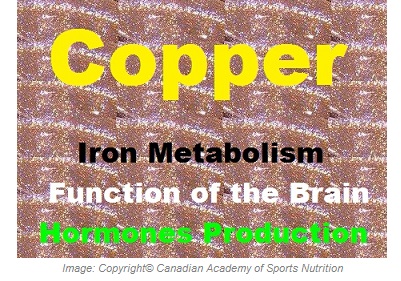Being an integral part of many enzymes, copper is an essential trace  mineral and plays an important role in iron metabolism. It is a component of ferroprotein, a protein that involves in iron transport across the intestinal cells.
mineral and plays an important role in iron metabolism. It is a component of ferroprotein, a protein that involves in iron transport across the intestinal cells.
Copper is also a part of superoxide dismutase (SOD), an enzyme with an antioxidant activity that is considered as a component of the body`s natural defence mechanism to scavenge free radicals.
Absorption and Functions of Copper:
Approximately 30% – 60% of copper intake is absorbed quickly into the blood stream from the stomach and upper part of the small intestine. The total amount of copper in the body is about 80 – 100 mg with the highest concentrations in the liver, brain, and muscles.
Normal blood level of copper is 100 mcg/dl, of which about 10% is free copper, and 90% is bound to the protein ceruloplasmin. The absorption of copper is significantly affected by zinc and vitamin C intake, as they interfere with copper absorption.
Functions of copper are as follows:
- Iron metabolism and formation of hemoglobin.
- Synthesis of melanin, a pigment that determines skin color.
- Energy production.
- Neurotransmitter production.
- Scavenging free radicals.
- Development and normal function of the CNS (central nervous system).
- Synthesis of collagen and elastin.
- Production of thyroid hormones.
- Production of adrenaline and histamine.
Food Sources:
Dietary sources of copper are shellfish, oysters, liver, nuts, legumes, buckwheat, and organ meats. Copper also gets into the body by using copper cookware and drinking water coming via copper pipes.
Copper deficiency is relatively rare and may manifest as anemia, growth retardation, mental deterioration, decreased bone density, hypothermia, changes in the color of skin and hair, hair loss, anorexia, dermatitis, fatigue, decreased thyroid function, weak immune system, and cardiovascular disease.
High doses of copper in the long term could lead to copper toxicity. It is usually associated with low zinc levels. Toxicity manifests as nausea, vomiting, diarrhea, tremors, stress, anxiety, poor memory, depression, musculoskeletal pain, insomnia, and poor concentration.
Athletic Benefits of Copper:
Copper may indirectly benefit athletes:
- May delay exhaustion time.
- May enhance endurance by increasing oxygenation.
- Helps speed up recovery from sports injuries, such as strains and sprains.
- Helps shorten reaction time by increasing production of adrenaline.
Non – Athletic Benefits of Copper:
Copper may benefit the following conditions:
- Iron deficiency anemia not responsive to iron supplements.
- Wound healing.
- Low function thyroid.
- Osteoporosis.
- High cholesterol.
- Benign prostatic hyperplasia (BPH).
- Vitiligo.
- Albinism.
- Chronic fatigue syndrome.
- Allergies.
- Stomach ulcers.
- Menkes` disease (a genetic disorder that causes severe copper deficiency).
Dosage and Side Effects:
The recommended daily allowance (RDA) for copper in adults is 900 mcg. Copper is a part of many multivitamins – multiminerals or is combined with zinc only. The usual dosage of copper is 2 – 3 mg a day. When combined with zinc, the best ratio of zinc-to-copper is 15 mg to 1 mg to balance out their absorption. The performance daily intake (PDI) for athletes and physically active people is 3 – 6 mg.
The tolerable upper intake for copper is 10 mg a day, and doses higher than this may cause liver toxicity. High doses of copper could cause nausea, vomiting, stomach upset, headache, dizziness, weakness, diarrhea, and a metallic taste in the mouth.
Contraindications and Interactions:
Copper should be avoided in the following conditions:
- Wilson`s disease: a genetic disorder that results in accumulation of copper in the liver and other organs.
- Scleroderma: copper accelerates collagen production, which may worsen symptoms of this disease. You may consult your doctor regarding taking copper if you have been diagnosed with scleroderma.
Copper has few interactions:
- Zinc: it decreases absorption of copper.
- Vitamin C: it interferes with copper absorption.
- Manganese: it interferes with copper absorption.
- Estrogen and birth control pills: they increase blood levels of copper.
- Nonsteroidal anti-inflammatory drugs (NSAIDs), such as Advil: copper may enhance their anti – inflammatory effects.
- Penicillamine: this medication reduces blood levels of copper.
- Corticosteroids: they may lower blood levels of copper.
- Cimetidine: it may increase blood levels of copper.

